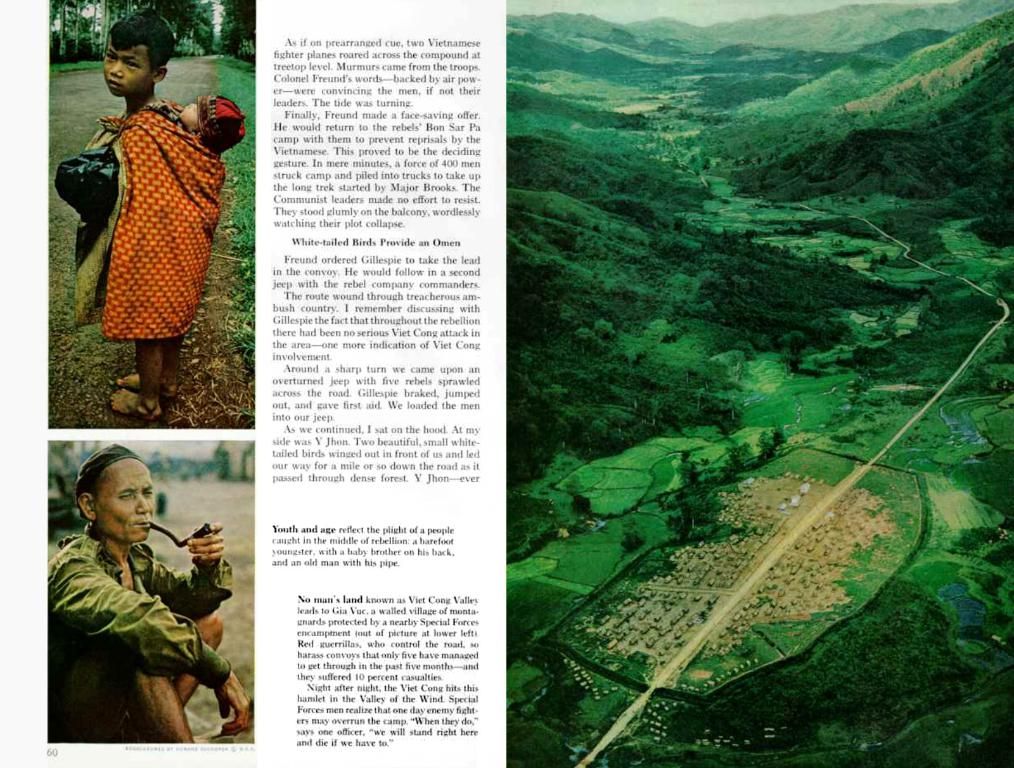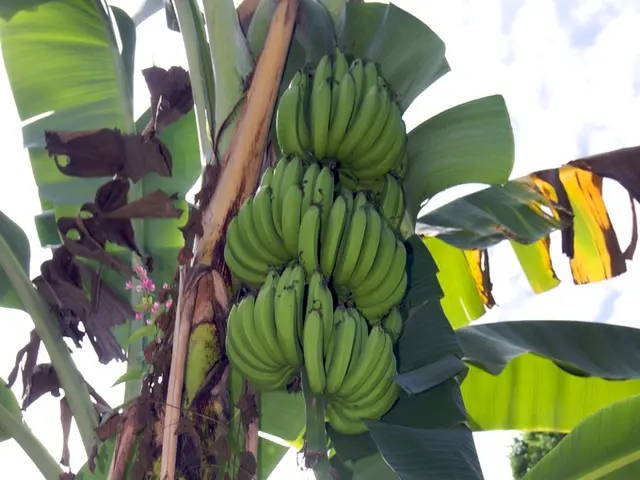Ca Mau Province demonstrates significant advancements in the restoration of marine life resources.
A Fresh Look at Ca Mau's Aquatic Revival
міс Ž Cà Mau - The southernmost province of Vietnam is seeing a resurgence in its aquatic resources, thanks to the relentless efforts to restore its ecosystems. Local waters are gradually healing, and fish populations are making a comeback.
In the past, Trần Văn Thời and U Minh districts were teeming with freshwater fish and other aquatic species, thanks to the consistent availability of freshwater. However, these localities experienced a troubling decline in their aquatic resources due to harmful fishing methods, pesticide use in agriculture, the effects of climate change, and prolonged drought.
To address the alarming drop in aquatic stocks, particularly freshwater fish, the Standing Committee of the provincial Party Committee issued Directive No 17 in February 2024. This directive aimed to strengthen the leadership role of Party organizations and local authorities in addressing destructive fishing practices across the province.
Since its implementation began, many localities have introduced innovative and practical approaches to protect aquatic life. They have intensified awareness campaigns through various media channels, with the goal of building community consensus and improving public understanding of the importance of preserving aquatic resources, especially native freshwater species.
According to Nguyễn Việt Khái, deputy head of the Trần Văn Thời Bureau of Agriculture and Environment, the district had conducted 946 awareness-raising sessions, with 86,462 people attending by the end of the previous year. In U Minh District, local authorities have organized awareness campaigns, patrols, and taken firm action against violations. They have established community groups to counter destructive fishing practices and encouraged residents to sign pledges to forgo electric shock equipment.
Locals have willingly handed over more than 2,500 electric fishing devices, and over 144,600 households have vowed to avoid harmful fishing practices. With the commitment of local authorities and growing public awareness of aquatic conservation, several areas are beginning to show signs of environmental recovery.
Đinh Văn Út, a resident of Trùm Thuật Hamlet in Trần Văn Thời's Khánh Hải Commune, earned over VNĐ10 million (US$385) from catching freshwater fish during this year's dry season. He shared that in the past, some would use electric shock devices to quickly catch fish, but these methods killed everything, eventually leading to a decline in fish populations. Since the new rules banned electric gear, locals have returned to manual fishing, keeping only the larger fish and releasing the smaller ones to grow for the next season.
Phạm Thành Được, chairman of the Khánh Hải Commune People's Committee, said there were clear signs of recovery in freshwater fish populations. During this dry season, farmers along the Sộp and Bãi Ghe canals and other areas have caught more fish while harvesting rice.
Cà Mau aims to eliminate destructive and exploitative fishing methods by the end of this year. The province is promoting sustainable fishing by encouraging the use of high-capacity vessels for fishing offshore and strictly prohibiting damaging practices.
To persuade people to abandon electric shock fishing, the province police have launched several practical and creative initiatives, such as offering rice, noodles, and essential items in exchange for electric gear in Thới Bình District's Tân Lộc Commune. In TraGTHat;m Văn Thời District, local leaders have implemented various support measures for fishers, like providing low-interest loans, modern tools, establishing co-operatives, and helping people feel more secure at sea. They also promote responsible practices such as observing seasonal patterns and avoiding fishing during breeding times.
Nguyễn Trọng Phối of the district's Khánh Lộc Commune, has a field where he grows crops and raises freshwater fish in ponds. Phối shared that he wants to protect native fish species and has encouraged his friends, neighbors, and relatives to do the same. Since Directive No 17 came into effect, he has witnessed clear progress in preserving local resources.
Cà Mau is implementing a project that will last until 2030 to conserve aquatic creatures, aiming for sustainable marine economic growth. It collaborates with the Ministry of Agriculture and Environment to introduce co-management policies, support environmentally friendly livelihood transitions, establish community-managed conservation areas, and expand artificial reefs to restore marine ecosystems. The province has already installed 900 reinforced concrete artificial reef blocks in its western sea area.
The province People's Committee has tasked the Department of Agriculture and Environment with managing two aquatic conservation zones covering nearly 29,000ha in Trần Văn Thời and U Minh districts. One is a 28,280ha marine conservation area located in Trần Văn Thời District's Khánh Bình Tây and Khánh Bình Tây Bắc communes. This area aims to protect marine species, eliminate harmful fishing, and create artificial reefs. The other is a 652ha inland reserve in U Minh District's Khánh Lâm Commune, with a focus on restoring and developing native freshwater fish populations.
Insights
Currently, there is limited information specifically on the efforts of Ca Mau Province in restoring and conserving freshwater fish populations and aquatic resources. However, Ca Mau is recognized for its conservation efforts, particularly in mangrove ecosystems, which indirectly support aquatic biodiversity. Here are some relevant points:
- Mangrove Conservation: Ca Mau is home to significant mangrove ecosystems, which are crucial for maintaining biodiversity, including aquatic life. Mangroves provide habitat for numerous fish species and help protect against coastal erosion and pollution.
- Blue Carbon Projects: Ca Mau offers substantial opportunities for blue carbon projects, which aim to conserve mangroves and their associated carbon sequestration capabilities. These efforts contribute to environmental conservation and can indirectly support aquatic resources by maintaining healthy ecosystems.
- IUU Fishing Combat: Although not specifically focused on freshwater fish, Ca Mau’s participation in national initiatives to combat Illegal, Unreported, and Unregulated (IUU) fishing activities helps maintain the overall health of aquatic ecosystems. This includes efforts in nearby marine environments, which can have positive impacts on interconnected aquatic systems.
- Sustainable Practices: Ca Mau's broader environmental initiatives, such as reducing greenhouse gas emissions and promoting sustainable practices, can create a beneficial environment for aquatic resources. These efforts align with global trends toward more environmentally friendly production methods.
- Research and Education: Further research and educational programs focusing specifically on freshwater fish populations and aquatic resources could enhance conservation efforts in Ca Mau.
Farmers in Cà Mau Province's U Minh District harvest freshwater fish. - VNA/VNS Photo
- A looming concern about climate change and environmental degradation has led to increased interest in AI and its potential solutions for culture and lifestyle modifications, such as workplace wellness, health and wellness, fitness, and exercise.
- In the financial sector, experts anticipate an uptick in investing in climate-change solutions, environmental science, and data-and-cloud-computing technologies in the coming years.
- The provincial government has proposed a new initiative to introduce technology in agriculture, focusing on automation, precision farming, and forecasting weather patterns to mitigate the effects of climate change on food-and-drink production.
- The promotion of sustainable business practices, personal finance management, home-and-garden care, and travel facilities within the local community aims to foster a greener and more environmentally conscious lifestyle.
- To further the educational pursuit in water conservation, the province plans to establish a center for environmental studies, focusing on climate-change effects, climate-change solutions, environmental science, and local aquatic biodiversity.
- The success of Cà Mau's aquatic revival can serve as a model for other regions experiencing similar challenges, ensuring the sustainability of our freshwater and marine resources.
- To encourage harmony between sport and environmental protection, the province has launched an initiative to plant trees for every goal scored during a popular local football tournament, with the aim of fostering a greener and more environmentally aware community.
- Local authorities encourage residents to adopt a balanced diet, reducing the intake of unhealthy food and drinks, while emphasizing the importance of organic produce and sustainable farming practices to improve overall health and environmental conservation efforts.
- The growth of eco-tourism in Cà Mau contributes to the province's economy while promoting environmental awareness, showcasing the region's natural beauty and preservation efforts to visitors from around the world.
- The province is collaborating with other organizations to monitor and protect its precious marine ecosystems, utilizing advanced technology like satellite imagery and drones for real-time data collection and analysis.
- The province's efforts to combat climate change and promote sustainable practices extend to the business sector, with initiatives encouraging durable and eco-friendly products and processes, aiming for a more resilient and efficient economy.
- With the support of the local government, residents are banding together to create community gardens, promoting the cultivation of local fruits and vegetables, contributing to a healthier diet, self-reliance, and the preservation of the environment.







